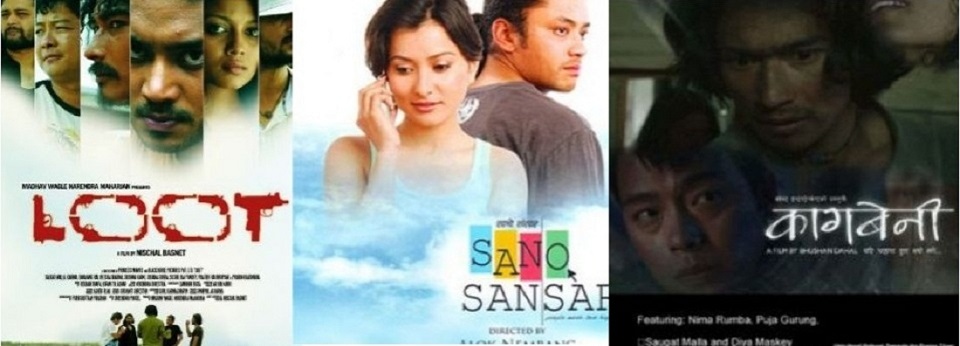
OR
Talking movies during the coronavirus pandemic
Published On: May 14, 2020 02:00 PM NPT By: Mukesh Khanal

There are several ways in which this pandemic can be an opportunity for the Nepali movie industry.
Recent weeks have seen a flurry of news items and interviews about the state of the Nepali movie industry in the face of the coronavirus pandemic.
There are dire predictions. One news item mentions that only about 10-15 Nepali movies will get made in 2020, compared to 100 in 2018 and about 55 in 2019 if news reports are to be believed. This is awful for a couple of reasons. First, if you want more Nepalis to watch local content, it is necessary to produce local content. The current pandemic has brought local movie making to a standstill. Second, it is called a movie business and an industry for a reason. The business/industry employs thousands of people, who suddenly find themselves without jobs and pay. This hurts hundreds of households that depend on these individuals for survival. The industry was already hurting before the pandemic due to a huge drop in the number of movies getting made. The pandemic has pushed it to the brink.
However, as the saying goes, every crisis is an opportunity. There are several ways in which this pandemic can be an opportunity for the Nepali movie industry.
First, this crisis will filter out hobbyist producers from overseas. I do not say this with ill intent. I believe people in Nepal have been exploiting Nepali producers who live overseas and bleeding them dry. The pandemic has also affected those foreign lands where those producers live, work and run their businesses. So, they too have suffered financial losses. For the next several years, they may not have money to throw around. This will significantly curtail the number of opportunistic garbage that Nepali film industry churns out every year on the backs of foreign money. It is time or local producers to figure out what kinds of movies need to be made and invest accordingly.
Second, the lockdown has helped increase film literacy among Nepali audiences. There are only so many Nepali movies one can watch in YouTube. So, people have resorted to watching movies and shows on online platforms like Netflix, Hotstar, Prime Video and others. Nepalis, locked in their homes, have been broadening their tastes and film education through international movies and shows. With this new knowledge, taste and appreciation of what international cinema looks and feels like, I hope Nepali audiences will start expecting and demanding similar content from our local industry. As in any market, when there is demand for something, the supply automatically starts flowing.
Third, if there is a change in our taste and expectation for better content, it will help grow the online platforms that cater to Nepalis. Currently, such platforms are happy purchasing or licensing somebody else’s content for a fee. They don’t actually own any of the content. The result is that these platforms end up buying and licensing the same garbage that the industry currently produces. That is a bad business model.
A changing taste among Nepali audiences for better content may force these platforms to finance and create original content, just like Netflix and Hotstar do. Heavyweights like Netflix may not greenlight an original Nepali movie or show for many more years to come. My hope is that Nepali OTT platforms will use the current pandemic as an opportunity to take initiative and expand their menu with original content. The future belongs to that OTT which has a headstart in this direction. Others have no future. A steady stream of original content will also ensure most technicians will continue to have steady jobs and be able to support their families by remaining in the industry.
Fourth, I see very few filmmakers who take the middle road between mass and class. Most creative types, who see themselves as representing the “class” in Nepali cinema, exist on one end of the spectrum as filmmakers who pride in competing in international film festivals and winning occasional accolades and prizes. Many such makers are darlings of the critics, but very few Nepalis get to see their output. On the other end are those that consider themselves the torchbearer of “mass” and their movies usually suck, to be frank. There are very few who stay in the middle with an aim of producing content that pleases the audience without insulting their intelligence. If critics happen to like their output, it’s a bonus. This middle group is what Nepali movie industry needs. Today, we’ve got too many David Mamet and David Dhawan wannabes in Nepal. We need more Hitchcocks and Kurosawas.
Finally, there is no progress if the industry keeps churning out garbage scripts. A house is only as strong as its foundation. That foundation for a movie or a show is its story, its script. We have producers financing a two-crore rupees movie on the backs of a two-lakh rupees screenplay. And, these producers wonder why their movie lost money. You get what you pay for. This is why you get a writer churning out five movie screenplays a year. Because the price of one does not feed his/her family! So, you get lots of plagiarism and lots of copy-and-paste writing. Like I said, you get what you pay for.
I hope this pandemic allows Nepali filmmakers—producers and directors—and the OTT platforms to put their thinking hat on, and question the way they’ve been doing business. Is this a sustainable strategy for growth? Where are the new ideas? Why aren’t there any new ideas?
You May Like This

Comedy of errors
Prime Minister’s office sometimes make such egregious mistakes that people wonder who actually run his office, if those who are... Read More...

We need a commander
As the nationwide lockdown enters its second week, people are desperately looking for a reassuring leader at the helm of... Read More...

Let's stay home
Nepal is on a weeklong nationwide lockdown from today. The second confirmed case of COVID-19 has been reported. People are... Read More...







Just In
- NRB to provide collateral-free loans to foreign employment seekers
- NEB to publish Grade 12 results next week
- Body handover begins; Relatives remain dissatisfied with insurance, compensation amount
- NC defers its plan to join Koshi govt
- NRB to review microfinance loan interest rate
- 134 dead in floods and landslides since onset of monsoon this year
- Mahakali Irrigation Project sees only 22 percent physical progress in 18 years
- Singapore now holds world's most powerful passport; Nepal stays at 98th












Leave A Comment